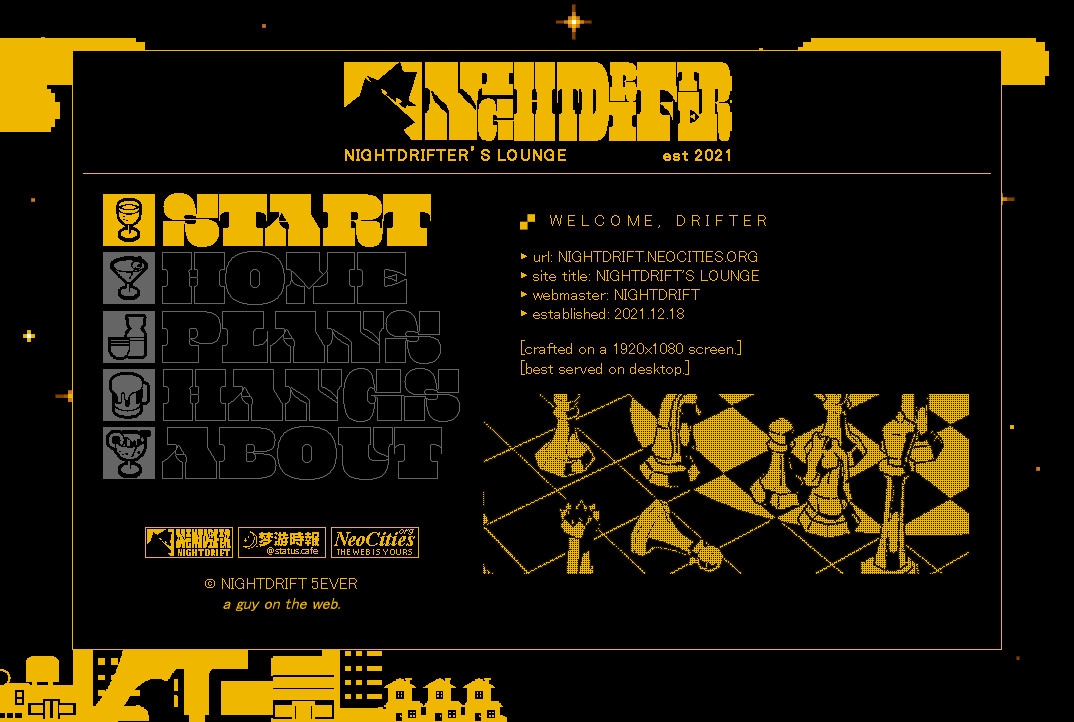Build your own website
I was going to start this post by talking about social media, but I think most of us are pretty well aware of the ways social media sucks. I follow some social media, but I don’t really post much on large sites. There’s stuff I would like to share online (hence this blog), but social media feels alienating and vaguely threatening to me.
In contrast, having my own website has been a joy. Building this website and participating on Ctrl-C Club has been a real experience of the magic of the internet for me. It’s so much fun to share things on my site and hear back from readers about their thoughts.
I also love having full creative control over my web presence here. There’s no social media site where I’d be able to have a profile page that looks like my gomepage. And no matter how customizable they get, those sites are (of necessity) restricted to specific structures and formats: you can only post videos on YouTube; you can only post tweets on Twitter.* With your own website, the only limits are your imagination and your skills.

There’s a higher barrier to entry when making your own website, because it requires you to learn HTML at a bare minimum, probably CSS as well, and eventually, you might want to add Javascript or even server-side code to it. But it’s not hard to grasp the barest basics to get a site started, and once you have a start, you can learn as you go. A site can be updated any time, so your site grows and improves over time as a reflection of your own journey of learning.
You don’t have to pay anything to start a website, either.
Gomepage started on Ctrl-C Club, which gives out free user profiles on a shared Linux machine, which include a public_html directory you can use to publish a user page.
There are a number of “tilde” servers that offer similar things.
If you don’t want to log in through a command line, there are other ways to host a static site for free. Neocities is a great site, inspired by the classic web host GeoCities. This is probably one of the easiest ways out there to get your own website. I love browsing around and seeing the fun, often retro sites people are building on there.
If you are familiar with git, the version control software, Github Pages and Cloudflare Pages both let you deploy a site automatically from files in a git repository, which is convenient. I’m sure there are plenty of other free options for hosting out there, but these are just the ones that come to me from memory.
Home-made personal websites take more time, effort, and attention than social media, and so they will likely never be as popular. But it means they draw a more intentional and engaged community of authors and users. No matter what the majority is doing, fun & interesting alternatives are out there, waiting for us. In the same way regenerative agriculture eschews raw efficiency for ecological resilience and diversity, having your own website is like building a digital homestead (or be as it may, a “gomestead”) that supports a healthier online ecosystem. Come join us!
Do you have a currently active personal site?
Have you tried making a website before?
Do you want to try making one?
Let me know your thoughts at my Ctrl-C email: gome @ ctrl-c.club.
* I know neither of these are perfect examples. On YouTube, you can now also make community posts, and Twitter in particular does allow some rudimentary forms of user-created structure with threading and quote-tweeting. But in either case, the format of the content will always be restricted to what features those sites have created.